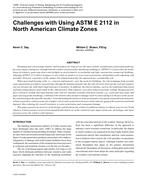Description
Designing and constructing window-wall interfaces for long service life must include consideration of potential pathways for water ingress and egress; through both the window system and the interfacing cladding(s). ASTM E 2112 prescribes the installation of windows, patio-type doors and skylights as used primarily in residential and light construction commercial buildings. Adopting ASTM E 2112 allows designers to rely solely on windows to resist water penetration, independent of the adjoining wall assembly. However, experience of the authors has demonstrated that this approach has considerable risk.
When mass load-bearing walls, i.e., concrete and masonry, were the norm for buildings, the risk of damage from periodic water penetration at windows (in particular through the framing elements into the sub-sill cavity between the wall and window) was low because the walls had a high tolerance to moisture. In addition, the interior finishes, such as the traditional lime-based wall and ceiling plasters used widely in the 19th and early 20th centuries, were more robust to periodic wetting. Design practices have evolved to include non-load bearing walls with less moisture resistant structural systems, e.g., wood and steel studs, and paper-faced gypsum sheathings, combined with windows that attempt to manage water by intercepting it at the face of the assembly, and draining at the operable interface. Notwithstanding the advances in the performance of sealants and membrane materials, reliance upon face sealed systems has a higher risk of water penetration because of the inherent aging of the materials and loads imposed, thus reducing the overall resistance to water penetration and consequent damage.
This paper presents an overview of the design considerations for window installation relative to climate zones across North America. It also presents a series of conceptual details that focus on the control of water ingress from rain, air leakage, and vapor pressure across the window-wall interface.
Presented at Thermal Performance of Exterior Envelopes of Whole Buildings X – December 2007
Units: I-P
Citation: Thermal Performance of Exterior Envelopes of Whole Buildings X
Product Details
- Published:
- 2008
- Number of Pages:
- 7
- File Size:
- 1 file , 4.3 MB
- Product Code(s):
- D-BldgsX144




